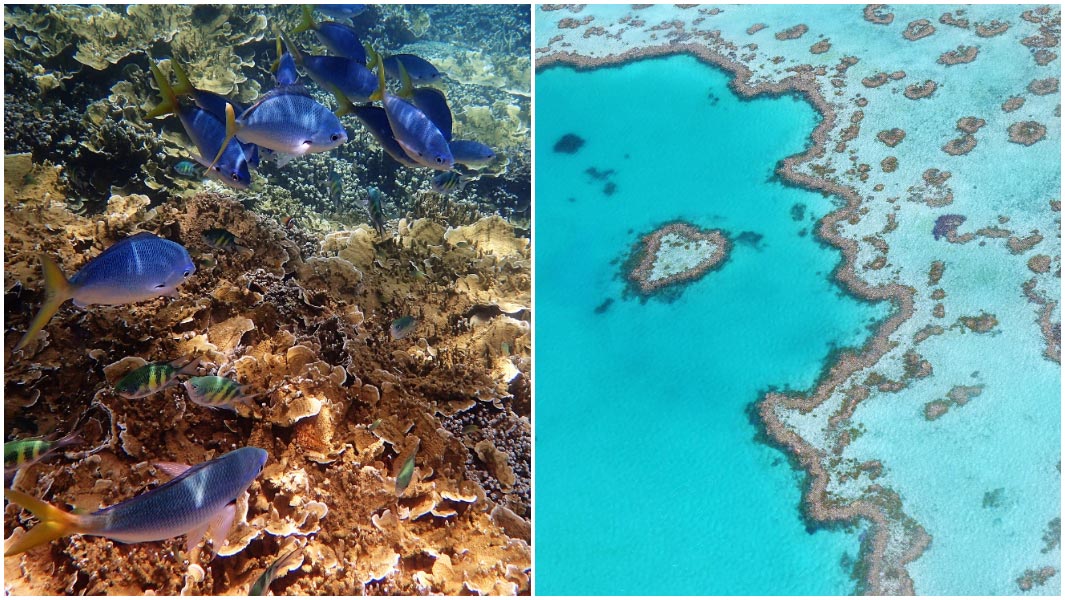How the Great Barrier Reef is dying and why you should care

The Great Barrier Reef is the world's longest reef, measuring 2,027 km (1,260 mi).
Running parallel to the coast of Queensland, Australia, the reef is an essential breeding ground for humpback whales and is home to over 1,500 species of tropical fish.
Visible from the Moon, the Great Barrier Reef is also the world’s largest marine animal structure, covering an area of 207,000 km² (80,000 mi²) and consisting of countless billions of corals.
The Great Barrier Reef took thousands of years to form, but in just a few short decades us humans have made remarkable progress in killing it.
Fortunately, it's not dead yet. Let’s examine the dangers facing the Great Barrier Reef and what can be done to save it.
How did the Great Barrier Reef form?
Aboriginal Australians have inhabited the Great Barrier Reef area for at least 40,000 years. They are recognized, along with the Torres Strait Islanders, to be the traditional owners of the reef.
Back then, the area wasn’t even underwater. Covered in forests, it was home to animals commonly found on the Australian plains.
10,000 years ago, at the end of the last Ice Age, the “Great Flood” occurred. As the ice at our planet’s poles melted and sea levels rose, Australia’s low lying coast was submerged.
The shallow, tropical waters became the perfect conditions for stony corals to thrive. Over hundreds of thousands of years, they built up to form the Great Barrier Reef.
Newly created and protected behind this long strip of reef was a lagoon larger in size than Great Britain. Former areas of high ground were now just small islands poking out of the water’s surface.
The Great Barrier Reef has existed in this state for thousands of years, but as a result of our actions, the delicate balance of this ecosystem is being devastated.

Why do we need the Great Barrier Reef?
Despite covering less than 1% of the ocean floor, coral reefs support an estimated 25% of all marine life.
Raine Island, located in the north of the Great Barrier Reef, is home to the world's largest green turtle rookery.
Up to 60,000 female green turtles migrate thousands of kilometres each breeding season to lay their eggs here. Upwards of 15,000 turtles at one time have been recorded attempting to nest along the 1.8-km beach.
But it’s not just turtles that thrive on Raine Island. Large populations of seabirds – around 16 different species - also nest and roost there, making it one of the most important seabird rookeries in the world.
Coral reefs are also crucial for supporting human life.
Due to the symbiotic relationship between corals and algae (zooxanthellae), they are responsible for producing half of the oxygen present in our atmosphere.
Additionally, coral reefs hold a record for providing the most wave protection by an animal structure. By absorbing approximately 97% of incoming wave energy, coral reefs shield some 100 million people who live in coastal zones worldwide.
So as we continue to destroy coral reefs, we also accelerate the destruction of our own species.

How is the Great Barrier Reef dying?
The Great Barrier Reef has suffered severe harm at the hands of humans. Toxic coastal pollution, overfishing and unsustainable tourism all contribute to the damage done.
However, the biggest threat of all is climate change, which causes coral bleaching and ocean acidification.
Coral bleaching is a process that causes coral to turn white in colour when exposed to certain stressors, such as changes in temperature or light.
As water temperatures rise due to climate change, the zooxanthellae algae living inside coral becomes toxic, so it is expelled. Not only do zooxanthellae produce coral’s pigmentation, they also provide 90% of the coral’s energy. Thus, without the algae, most corals starve and die.
Unfortunately, coral bleaching events are now occurring at an alarming rate.
Mass coral bleaching events in the Great Barrier Reef have been recorded in 1998, 2002, 2006, 2016, 2017 and 2020, and they are now expected to become an annual occurrence.
In March 2022, the latest mass coral bleaching event began, as confirmed by the Great Barrier Reef Marine Park Authority.
The longest global coral bleaching event ever was recorded between June 2014 and May 2017, owing to an unprecedented run of hot years, exacerbated by the strong 2015–16 El Niño event.
Notably, 2022 is the first time mass bleaching has happened in a cooler La Niña year.
The Great Barrier Reef is estimated to have lost over 50% of its corals since 1995 and as global warming continues, this number will continue to increase exponentially.

Can the Great Barrier Reef be saved?
In 2015, the Australian government formed a plan for the protection and preservation of the Great Barrier Reef until 2050.
Whilst the plan contains many commendable aims to improve water quality and restore the reef, there are no measures to tackle the root cause of the issue – climate change.
A 2017 study by ecologists at James Cook University in Australia concluded that the only way to preserve the world's coral reefs will be to take drastic action to reverse global warming.
The time left until temperatures warm by 1.5 °C is rapidly running out and once we reach that stage, the Great Barrier Reef as we know it will be gone.
Addressing the most important problem of our generation will require many solutions, such as investing in renewable energy, keeping fossil fuels in the ground, protecting forests, reducing plastic production and clamping down on unsustainable business practices.
Reversing the damage done to the Great Barrier Reef - and other ecosystems around the world - will be no easy feat, but if we can inspire change in individuals, corporations and governments, there may be hope yet.


